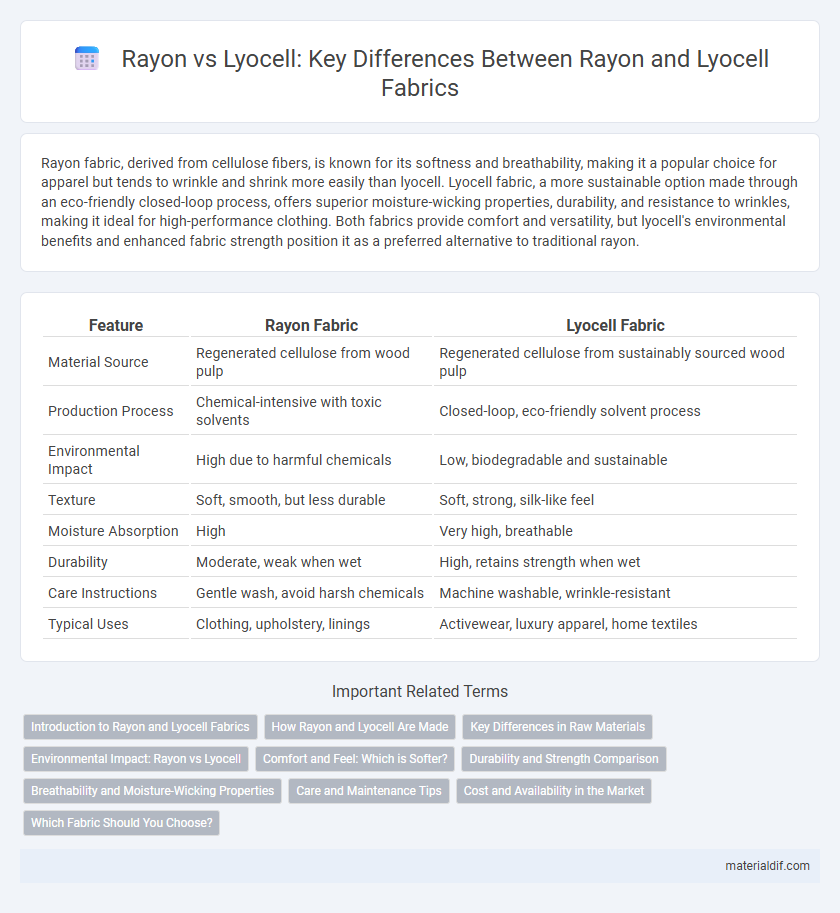Rayon fabric, derived from cellulose fibers, is known for its softness and breathability, making it a popular choice for apparel but tends to wrinkle and shrink more easily than lyocell. Lyocell fabric, a more sustainable option made through an eco-friendly closed-loop process, offers superior moisture-wicking properties, durability, and resistance to wrinkles, making it ideal for high-performance clothing. Both fabrics provide comfort and versatility, but lyocell's environmental benefits and enhanced fabric strength position it as a preferred alternative to traditional rayon.
Table of Comparison
| Feature | Rayon Fabric | Lyocell Fabric |
|---|---|---|
| Material Source | Regenerated cellulose from wood pulp | Regenerated cellulose from sustainably sourced wood pulp |
| Production Process | Chemical-intensive with toxic solvents | Closed-loop, eco-friendly solvent process |
| Environmental Impact | High due to harmful chemicals | Low, biodegradable and sustainable |
| Texture | Soft, smooth, but less durable | Soft, strong, silk-like feel |
| Moisture Absorption | High | Very high, breathable |
| Durability | Moderate, weak when wet | High, retains strength when wet |
| Care Instructions | Gentle wash, avoid harsh chemicals | Machine washable, wrinkle-resistant |
| Typical Uses | Clothing, upholstery, linings | Activewear, luxury apparel, home textiles |
Introduction to Rayon and Lyocell Fabrics
Rayon fabric is a versatile semi-synthetic fiber made from regenerated cellulose, primarily derived from wood pulp, known for its smooth texture and breathability. Lyocell fabric is a more sustainable variant of rayon, produced through a closed-loop process that recycles solvents, leading to eco-friendly and biodegradable material with superior strength and moisture-wicking properties. Both fabrics are popular in textiles for their softness and drape, but lyocell stands out for its environmentally conscious production and durability.
How Rayon and Lyocell Are Made
Rayon fabric is produced through a chemical process that dissolves cellulose from wood pulp using carbon disulfide and sodium hydroxide, creating a viscous solution that is spun into fibers. Lyocell fabric is made by dissolving wood pulp in a non-toxic solvent, N-methylmorpholine N-oxide, in a closed-loop system that recycles over 99% of the solvent, making it more environmentally friendly. Both fibers derive from cellulose but differ significantly in their manufacturing processes and environmental impact.
Key Differences in Raw Materials
Rayon fabric is primarily made from wood pulp treated with chemical solvents like carbon disulfide and sodium hydroxide, resulting in a semi-synthetic fiber, while lyocell fabric is produced through a more eco-friendly process using dissolving pulp and a non-toxic solvent called N-methylmorpholine N-oxide (NMMO). The key difference lies in rayon's higher chemical usage and environmental impact compared to lyocell's closed-loop production system that recycles over 99% of its solvents. This distinction in raw materials and manufacturing processes significantly affects fabric sustainability, strength, and moisture absorption properties.
Environmental Impact: Rayon vs Lyocell
Rayon production heavily relies on chemical-intensive processes that generate toxic waste, leading to significant environmental pollution and deforestation due to raw material sourcing from wood pulp. In contrast, lyocell fabric is produced using a closed-loop process that recycles solvents, minimizing harmful emissions and reducing the environmental footprint. The sustainable sourcing of fast-growing eucalyptus trees for lyocell further decreases the impact on biodiversity compared to traditional rayon raw materials.
Comfort and Feel: Which is Softer?
Rayon fabric offers a smooth, silky feel with excellent breathability, making it comfortable for warm weather. Lyocell, derived from sustainably sourced wood pulp, provides a softer and more luxurious texture with superior moisture-wicking properties. Overall, lyocell is often regarded as softer and more gentle on the skin compared to traditional rayon.
Durability and Strength Comparison
Rayon fabric exhibits moderate durability but tends to weaken when exposed to moisture, making it less resilient over time compared to Lyocell. Lyocell fabric, derived from sustainably sourced wood pulp, offers superior strength and greater resistance to wear, washing, and stretching. This enhanced durability makes Lyocell a preferred choice for long-lasting textiles in both apparel and home furnishings.
Breathability and Moisture-Wicking Properties
Rayon fabric offers moderate breathability and absorbs moisture well, making it suitable for warm climates but less effective at quick drying. Lyocell fabric, derived from sustainable wood pulp, excels in breathability and features superior moisture-wicking properties, drawing sweat away from the skin and drying faster. The advanced fiber structure of lyocell enhances comfort by maintaining dryness and airflow, outperforming traditional rayon in activewear and high-performance textiles.
Care and Maintenance Tips
Rayon fabric requires gentle hand washing or machine washing on a delicate cycle with cold water to prevent shrinking and distortion, while Lyocell fabric can usually withstand machine washing with mild detergent and cold water without losing its shape. Both fabrics benefit from air drying flat or hanging to avoid wrinkles and damage from high heat, but Lyocell resists wrinkles better than Rayon. Avoid bleach and high-temperature ironing on Rayon, whereas Lyocell tolerates low to medium heat ironing, enhancing its durability and appearance.
Cost and Availability in the Market
Rayon fabric generally offers a lower cost compared to lyocell due to its less complex manufacturing process and widespread availability across global textile markets. Lyocell, produced through a more environmentally friendly and costly solvent-spinning method, is often positioned as a premium fabric and can be less readily available in mainstream retail stores. Bulk buyers and manufacturers tend to favor rayon for budget-friendly applications, while lyocell appeals to eco-conscious brands prioritizing sustainable textile options.
Which Fabric Should You Choose?
Rayon fabric, derived from regenerated cellulose fibers, offers a soft, breathable texture suitable for everyday wear, while lyocell fabric, a type of rayon produced through a more eco-friendly closed-loop process, provides enhanced durability and moisture-wicking properties. Choosing between rayon and lyocell depends on your priorities: rayon is ideal for budget-friendly, lightweight garments, whereas lyocell is better for sustainable fashion and performance-focused clothing. Consider factors like environmental impact, fabric care, and intended garment use when deciding which fabric best meets your needs.
Rayon Fabric vs Lyocell Fabric Infographic

 materialdif.com
materialdif.com